Management and Operations: Leadership and Management in Unilever
VerifiedAdded on 2022/09/13
|11
|3349
|13
Report
AI Summary
This report provides a comprehensive analysis of the differences between management and leadership, using Unilever as a case study. It explores the key responsibilities of managers and leaders, examining interpersonal, informational, and decisional roles. The report delves into leadership styles, including transactional and transformational leadership, and introduces the Action-Centred Leadership model. It also discusses situational leadership theory and its practical applications. The report highlights the importance of effective leadership in achieving organizational goals and fostering employee motivation, referencing Unilever's leadership development programs and its focus on sustainable growth. The report also examines the concept of operations as both a function and a process which all organisations must adopt to conduct business.
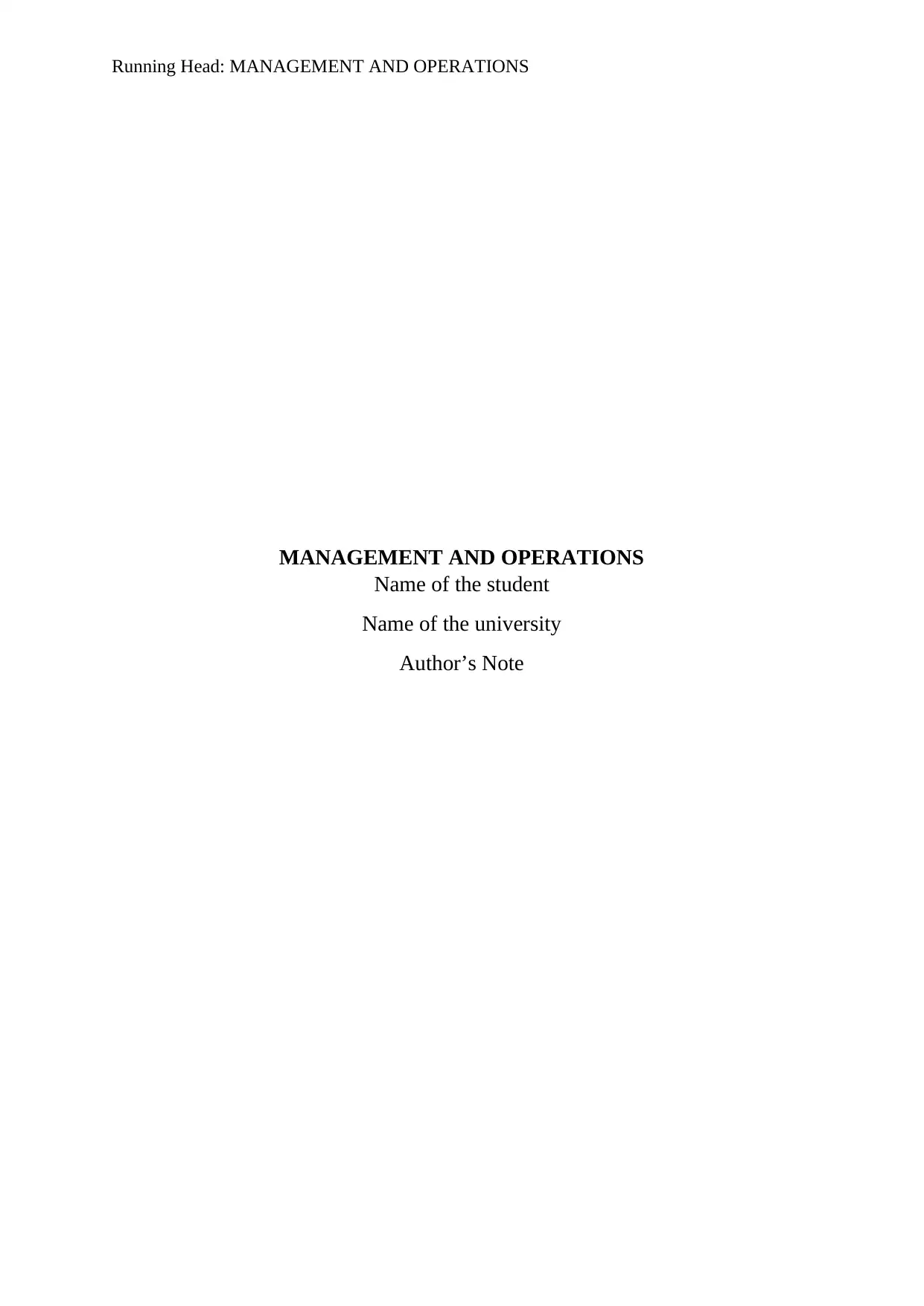
Running Head: MANAGEMENT AND OPERATIONS
MANAGEMENT AND OPERATIONS
Name of the student
Name of the university
Author’s Note
MANAGEMENT AND OPERATIONS
Name of the student
Name of the university
Author’s Note
Paraphrase This Document
Need a fresh take? Get an instant paraphrase of this document with our AI Paraphraser
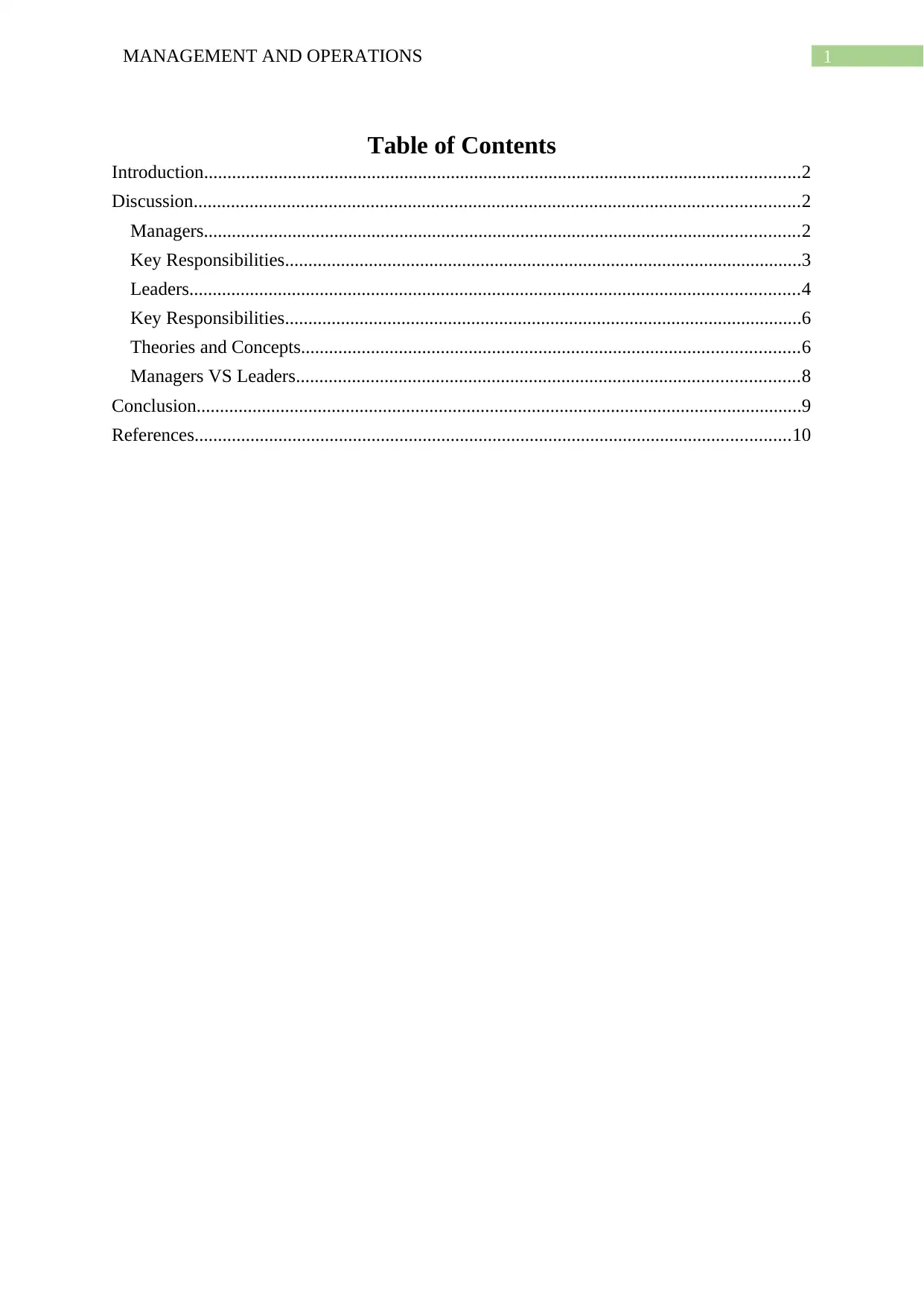
1MANAGEMENT AND OPERATIONS
Table of Contents
Introduction................................................................................................................................2
Discussion..................................................................................................................................2
Managers................................................................................................................................2
Key Responsibilities...............................................................................................................3
Leaders...................................................................................................................................4
Key Responsibilities...............................................................................................................6
Theories and Concepts...........................................................................................................6
Managers VS Leaders............................................................................................................8
Conclusion..................................................................................................................................9
References................................................................................................................................10
Table of Contents
Introduction................................................................................................................................2
Discussion..................................................................................................................................2
Managers................................................................................................................................2
Key Responsibilities...............................................................................................................3
Leaders...................................................................................................................................4
Key Responsibilities...............................................................................................................6
Theories and Concepts...........................................................................................................6
Managers VS Leaders............................................................................................................8
Conclusion..................................................................................................................................9
References................................................................................................................................10
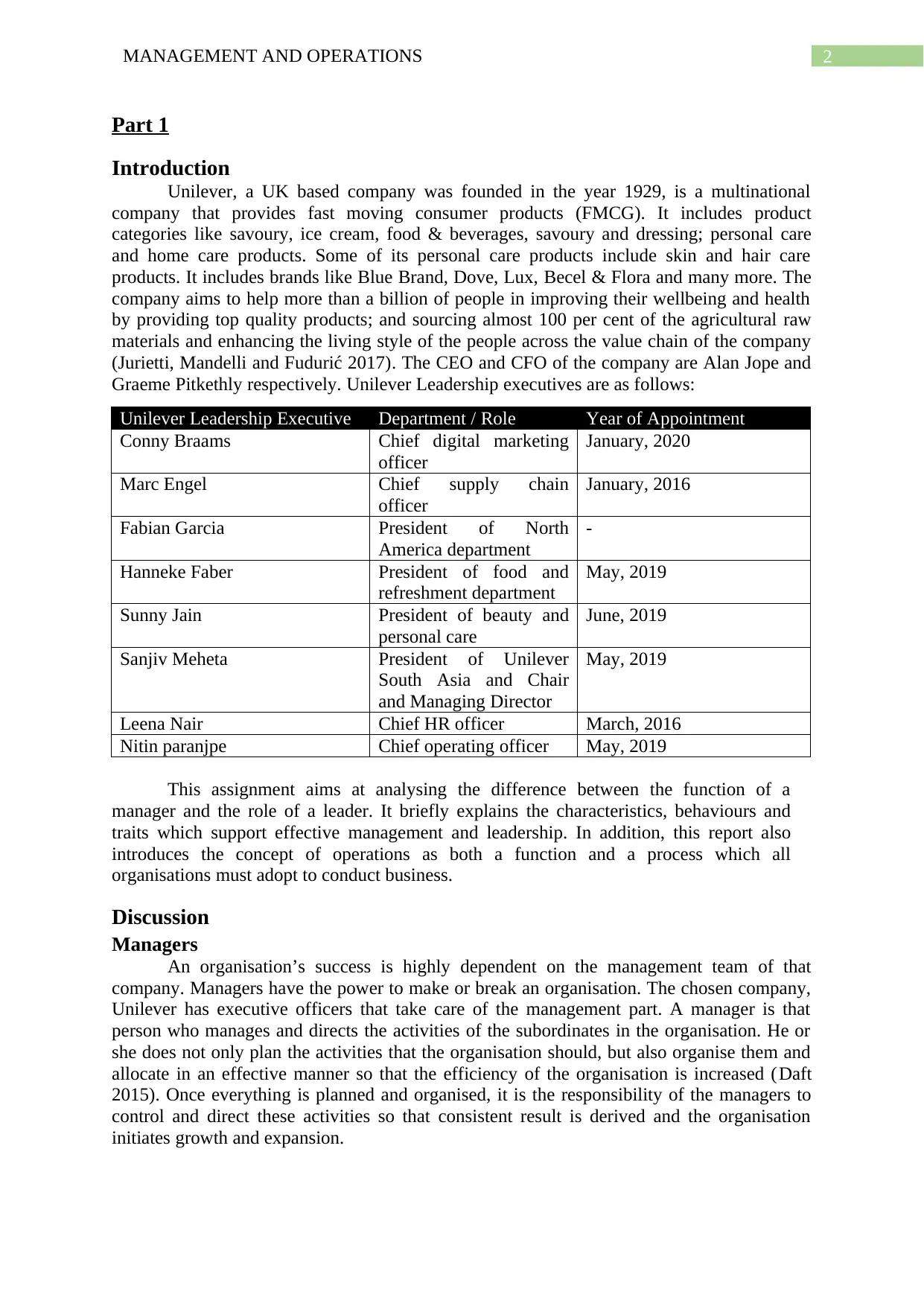
2MANAGEMENT AND OPERATIONS
Part 1
Introduction
Unilever, a UK based company was founded in the year 1929, is a multinational
company that provides fast moving consumer products (FMCG). It includes product
categories like savoury, ice cream, food & beverages, savoury and dressing; personal care
and home care products. Some of its personal care products include skin and hair care
products. It includes brands like Blue Brand, Dove, Lux, Becel & Flora and many more. The
company aims to help more than a billion of people in improving their wellbeing and health
by providing top quality products; and sourcing almost 100 per cent of the agricultural raw
materials and enhancing the living style of the people across the value chain of the company
(Jurietti, Mandelli and Fudurić 2017). The CEO and CFO of the company are Alan Jope and
Graeme Pitkethly respectively. Unilever Leadership executives are as follows:
Unilever Leadership Executive Department / Role Year of Appointment
Conny Braams Chief digital marketing
officer
January, 2020
Marc Engel Chief supply chain
officer
January, 2016
Fabian Garcia President of North
America department
-
Hanneke Faber President of food and
refreshment department
May, 2019
Sunny Jain President of beauty and
personal care
June, 2019
Sanjiv Meheta President of Unilever
South Asia and Chair
and Managing Director
May, 2019
Leena Nair Chief HR officer March, 2016
Nitin paranjpe Chief operating officer May, 2019
This assignment aims at analysing the difference between the function of a
manager and the role of a leader. It briefly explains the characteristics, behaviours and
traits which support effective management and leadership. In addition, this report also
introduces the concept of operations as both a function and a process which all
organisations must adopt to conduct business.
Discussion
Managers
An organisation’s success is highly dependent on the management team of that
company. Managers have the power to make or break an organisation. The chosen company,
Unilever has executive officers that take care of the management part. A manager is that
person who manages and directs the activities of the subordinates in the organisation. He or
she does not only plan the activities that the organisation should, but also organise them and
allocate in an effective manner so that the efficiency of the organisation is increased (Daft
2015). Once everything is planned and organised, it is the responsibility of the managers to
control and direct these activities so that consistent result is derived and the organisation
initiates growth and expansion.
Part 1
Introduction
Unilever, a UK based company was founded in the year 1929, is a multinational
company that provides fast moving consumer products (FMCG). It includes product
categories like savoury, ice cream, food & beverages, savoury and dressing; personal care
and home care products. Some of its personal care products include skin and hair care
products. It includes brands like Blue Brand, Dove, Lux, Becel & Flora and many more. The
company aims to help more than a billion of people in improving their wellbeing and health
by providing top quality products; and sourcing almost 100 per cent of the agricultural raw
materials and enhancing the living style of the people across the value chain of the company
(Jurietti, Mandelli and Fudurić 2017). The CEO and CFO of the company are Alan Jope and
Graeme Pitkethly respectively. Unilever Leadership executives are as follows:
Unilever Leadership Executive Department / Role Year of Appointment
Conny Braams Chief digital marketing
officer
January, 2020
Marc Engel Chief supply chain
officer
January, 2016
Fabian Garcia President of North
America department
-
Hanneke Faber President of food and
refreshment department
May, 2019
Sunny Jain President of beauty and
personal care
June, 2019
Sanjiv Meheta President of Unilever
South Asia and Chair
and Managing Director
May, 2019
Leena Nair Chief HR officer March, 2016
Nitin paranjpe Chief operating officer May, 2019
This assignment aims at analysing the difference between the function of a
manager and the role of a leader. It briefly explains the characteristics, behaviours and
traits which support effective management and leadership. In addition, this report also
introduces the concept of operations as both a function and a process which all
organisations must adopt to conduct business.
Discussion
Managers
An organisation’s success is highly dependent on the management team of that
company. Managers have the power to make or break an organisation. The chosen company,
Unilever has executive officers that take care of the management part. A manager is that
person who manages and directs the activities of the subordinates in the organisation. He or
she does not only plan the activities that the organisation should, but also organise them and
allocate in an effective manner so that the efficiency of the organisation is increased (Daft
2015). Once everything is planned and organised, it is the responsibility of the managers to
control and direct these activities so that consistent result is derived and the organisation
initiates growth and expansion.
⊘ This is a preview!⊘
Do you want full access?
Subscribe today to unlock all pages.

Trusted by 1+ million students worldwide
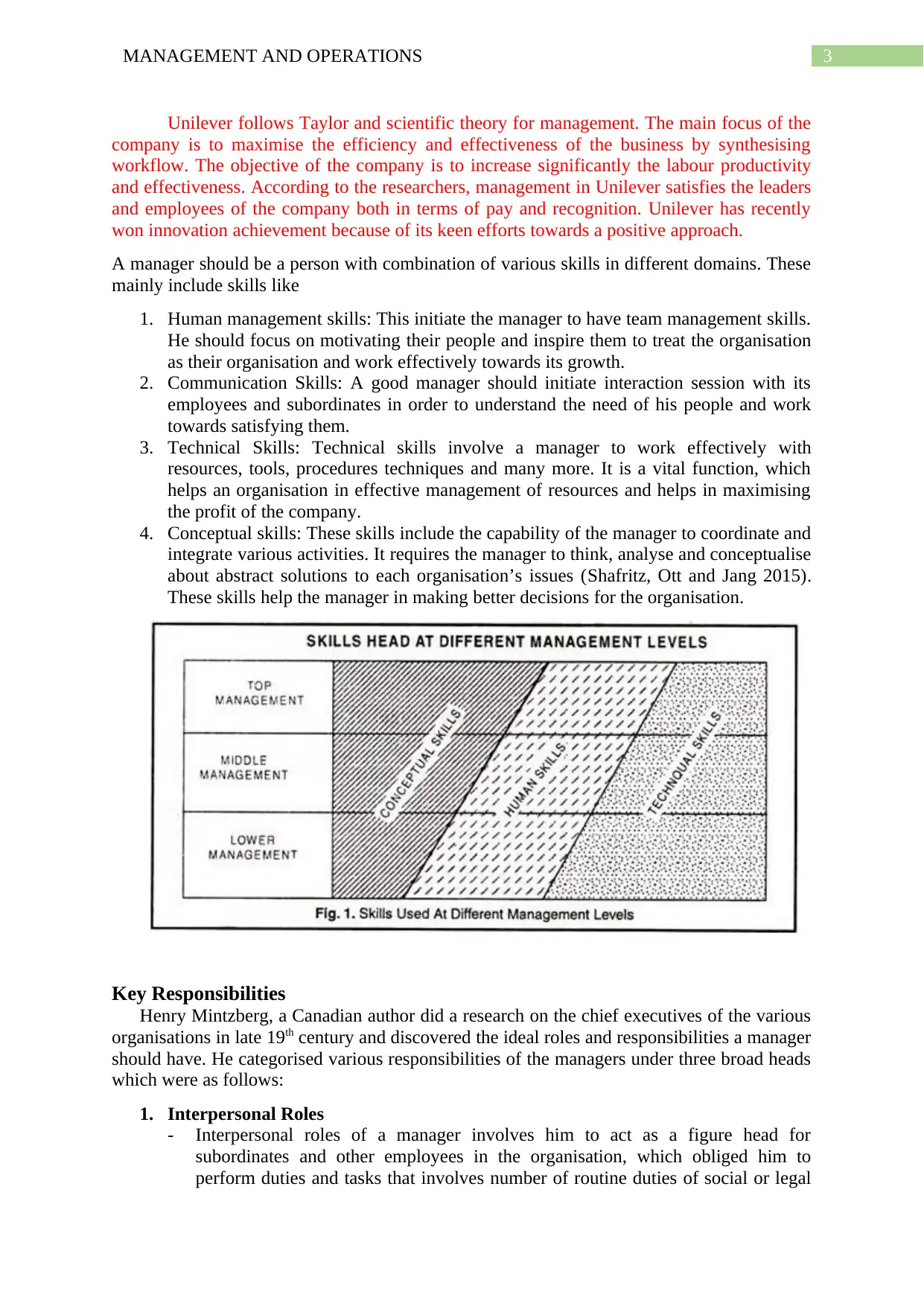
3MANAGEMENT AND OPERATIONS
Unilever follows Taylor and scientific theory for management. The main focus of the
company is to maximise the efficiency and effectiveness of the business by synthesising
workflow. The objective of the company is to increase significantly the labour productivity
and effectiveness. According to the researchers, management in Unilever satisfies the leaders
and employees of the company both in terms of pay and recognition. Unilever has recently
won innovation achievement because of its keen efforts towards a positive approach.
A manager should be a person with combination of various skills in different domains. These
mainly include skills like
1. Human management skills: This initiate the manager to have team management skills.
He should focus on motivating their people and inspire them to treat the organisation
as their organisation and work effectively towards its growth.
2. Communication Skills: A good manager should initiate interaction session with its
employees and subordinates in order to understand the need of his people and work
towards satisfying them.
3. Technical Skills: Technical skills involve a manager to work effectively with
resources, tools, procedures techniques and many more. It is a vital function, which
helps an organisation in effective management of resources and helps in maximising
the profit of the company.
4. Conceptual skills: These skills include the capability of the manager to coordinate and
integrate various activities. It requires the manager to think, analyse and conceptualise
about abstract solutions to each organisation’s issues (Shafritz, Ott and Jang 2015).
These skills help the manager in making better decisions for the organisation.
Key Responsibilities
Henry Mintzberg, a Canadian author did a research on the chief executives of the various
organisations in late 19th century and discovered the ideal roles and responsibilities a manager
should have. He categorised various responsibilities of the managers under three broad heads
which were as follows:
1. Interpersonal Roles
- Interpersonal roles of a manager involves him to act as a figure head for
subordinates and other employees in the organisation, which obliged him to
perform duties and tasks that involves number of routine duties of social or legal
Unilever follows Taylor and scientific theory for management. The main focus of the
company is to maximise the efficiency and effectiveness of the business by synthesising
workflow. The objective of the company is to increase significantly the labour productivity
and effectiveness. According to the researchers, management in Unilever satisfies the leaders
and employees of the company both in terms of pay and recognition. Unilever has recently
won innovation achievement because of its keen efforts towards a positive approach.
A manager should be a person with combination of various skills in different domains. These
mainly include skills like
1. Human management skills: This initiate the manager to have team management skills.
He should focus on motivating their people and inspire them to treat the organisation
as their organisation and work effectively towards its growth.
2. Communication Skills: A good manager should initiate interaction session with its
employees and subordinates in order to understand the need of his people and work
towards satisfying them.
3. Technical Skills: Technical skills involve a manager to work effectively with
resources, tools, procedures techniques and many more. It is a vital function, which
helps an organisation in effective management of resources and helps in maximising
the profit of the company.
4. Conceptual skills: These skills include the capability of the manager to coordinate and
integrate various activities. It requires the manager to think, analyse and conceptualise
about abstract solutions to each organisation’s issues (Shafritz, Ott and Jang 2015).
These skills help the manager in making better decisions for the organisation.
Key Responsibilities
Henry Mintzberg, a Canadian author did a research on the chief executives of the various
organisations in late 19th century and discovered the ideal roles and responsibilities a manager
should have. He categorised various responsibilities of the managers under three broad heads
which were as follows:
1. Interpersonal Roles
- Interpersonal roles of a manager involves him to act as a figure head for
subordinates and other employees in the organisation, which obliged him to
perform duties and tasks that involves number of routine duties of social or legal
Paraphrase This Document
Need a fresh take? Get an instant paraphrase of this document with our AI Paraphraser
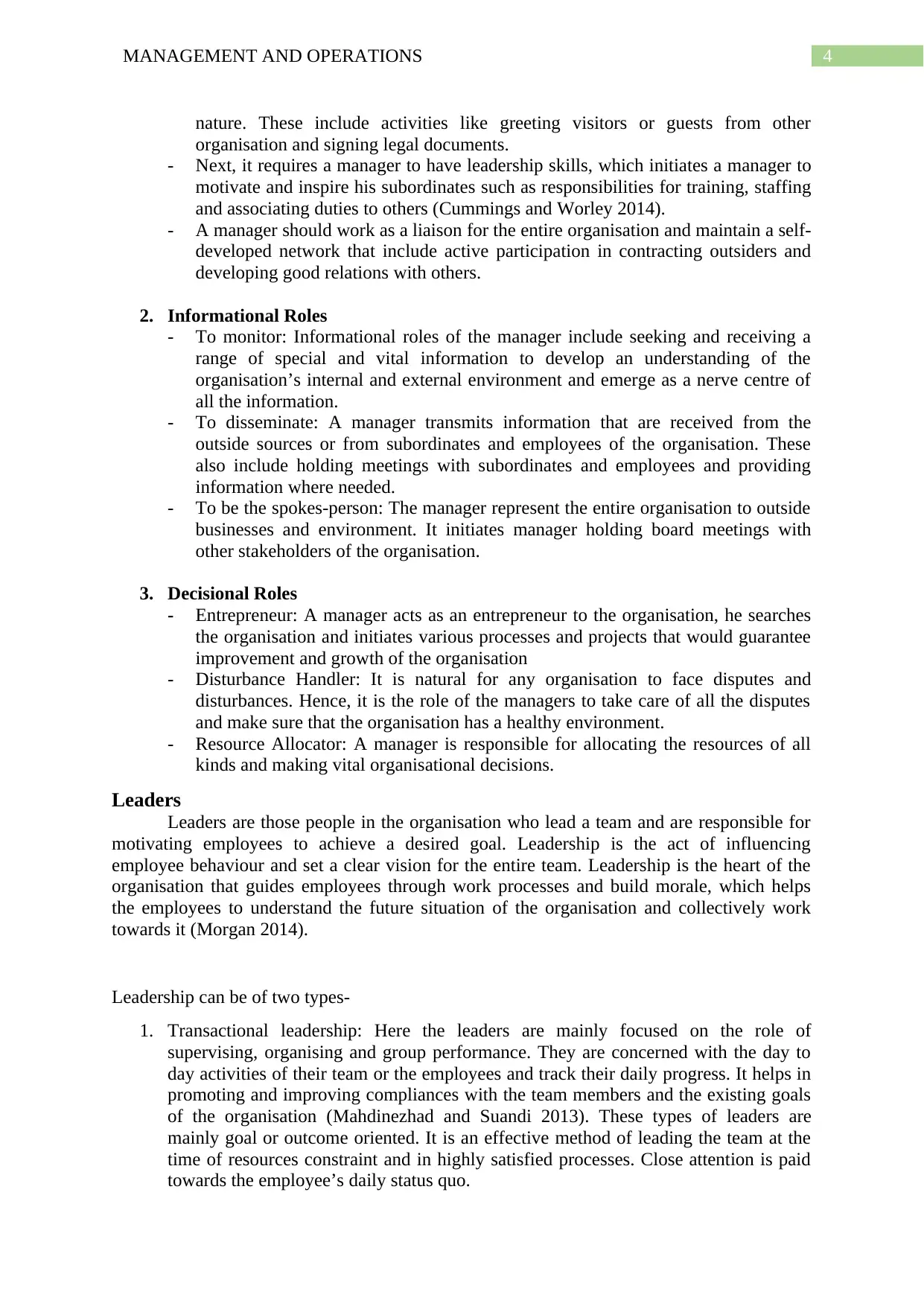
4MANAGEMENT AND OPERATIONS
nature. These include activities like greeting visitors or guests from other
organisation and signing legal documents.
- Next, it requires a manager to have leadership skills, which initiates a manager to
motivate and inspire his subordinates such as responsibilities for training, staffing
and associating duties to others (Cummings and Worley 2014).
- A manager should work as a liaison for the entire organisation and maintain a self-
developed network that include active participation in contracting outsiders and
developing good relations with others.
2. Informational Roles
- To monitor: Informational roles of the manager include seeking and receiving a
range of special and vital information to develop an understanding of the
organisation’s internal and external environment and emerge as a nerve centre of
all the information.
- To disseminate: A manager transmits information that are received from the
outside sources or from subordinates and employees of the organisation. These
also include holding meetings with subordinates and employees and providing
information where needed.
- To be the spokes-person: The manager represent the entire organisation to outside
businesses and environment. It initiates manager holding board meetings with
other stakeholders of the organisation.
3. Decisional Roles
- Entrepreneur: A manager acts as an entrepreneur to the organisation, he searches
the organisation and initiates various processes and projects that would guarantee
improvement and growth of the organisation
- Disturbance Handler: It is natural for any organisation to face disputes and
disturbances. Hence, it is the role of the managers to take care of all the disputes
and make sure that the organisation has a healthy environment.
- Resource Allocator: A manager is responsible for allocating the resources of all
kinds and making vital organisational decisions.
Leaders
Leaders are those people in the organisation who lead a team and are responsible for
motivating employees to achieve a desired goal. Leadership is the act of influencing
employee behaviour and set a clear vision for the entire team. Leadership is the heart of the
organisation that guides employees through work processes and build morale, which helps
the employees to understand the future situation of the organisation and collectively work
towards it (Morgan 2014).
Leadership can be of two types-
1. Transactional leadership: Here the leaders are mainly focused on the role of
supervising, organising and group performance. They are concerned with the day to
day activities of their team or the employees and track their daily progress. It helps in
promoting and improving compliances with the team members and the existing goals
of the organisation (Mahdinezhad and Suandi 2013). These types of leaders are
mainly goal or outcome oriented. It is an effective method of leading the team at the
time of resources constraint and in highly satisfied processes. Close attention is paid
towards the employee’s daily status quo.
nature. These include activities like greeting visitors or guests from other
organisation and signing legal documents.
- Next, it requires a manager to have leadership skills, which initiates a manager to
motivate and inspire his subordinates such as responsibilities for training, staffing
and associating duties to others (Cummings and Worley 2014).
- A manager should work as a liaison for the entire organisation and maintain a self-
developed network that include active participation in contracting outsiders and
developing good relations with others.
2. Informational Roles
- To monitor: Informational roles of the manager include seeking and receiving a
range of special and vital information to develop an understanding of the
organisation’s internal and external environment and emerge as a nerve centre of
all the information.
- To disseminate: A manager transmits information that are received from the
outside sources or from subordinates and employees of the organisation. These
also include holding meetings with subordinates and employees and providing
information where needed.
- To be the spokes-person: The manager represent the entire organisation to outside
businesses and environment. It initiates manager holding board meetings with
other stakeholders of the organisation.
3. Decisional Roles
- Entrepreneur: A manager acts as an entrepreneur to the organisation, he searches
the organisation and initiates various processes and projects that would guarantee
improvement and growth of the organisation
- Disturbance Handler: It is natural for any organisation to face disputes and
disturbances. Hence, it is the role of the managers to take care of all the disputes
and make sure that the organisation has a healthy environment.
- Resource Allocator: A manager is responsible for allocating the resources of all
kinds and making vital organisational decisions.
Leaders
Leaders are those people in the organisation who lead a team and are responsible for
motivating employees to achieve a desired goal. Leadership is the act of influencing
employee behaviour and set a clear vision for the entire team. Leadership is the heart of the
organisation that guides employees through work processes and build morale, which helps
the employees to understand the future situation of the organisation and collectively work
towards it (Morgan 2014).
Leadership can be of two types-
1. Transactional leadership: Here the leaders are mainly focused on the role of
supervising, organising and group performance. They are concerned with the day to
day activities of their team or the employees and track their daily progress. It helps in
promoting and improving compliances with the team members and the existing goals
of the organisation (Mahdinezhad and Suandi 2013). These types of leaders are
mainly goal or outcome oriented. It is an effective method of leading the team at the
time of resources constraint and in highly satisfied processes. Close attention is paid
towards the employee’s daily status quo.
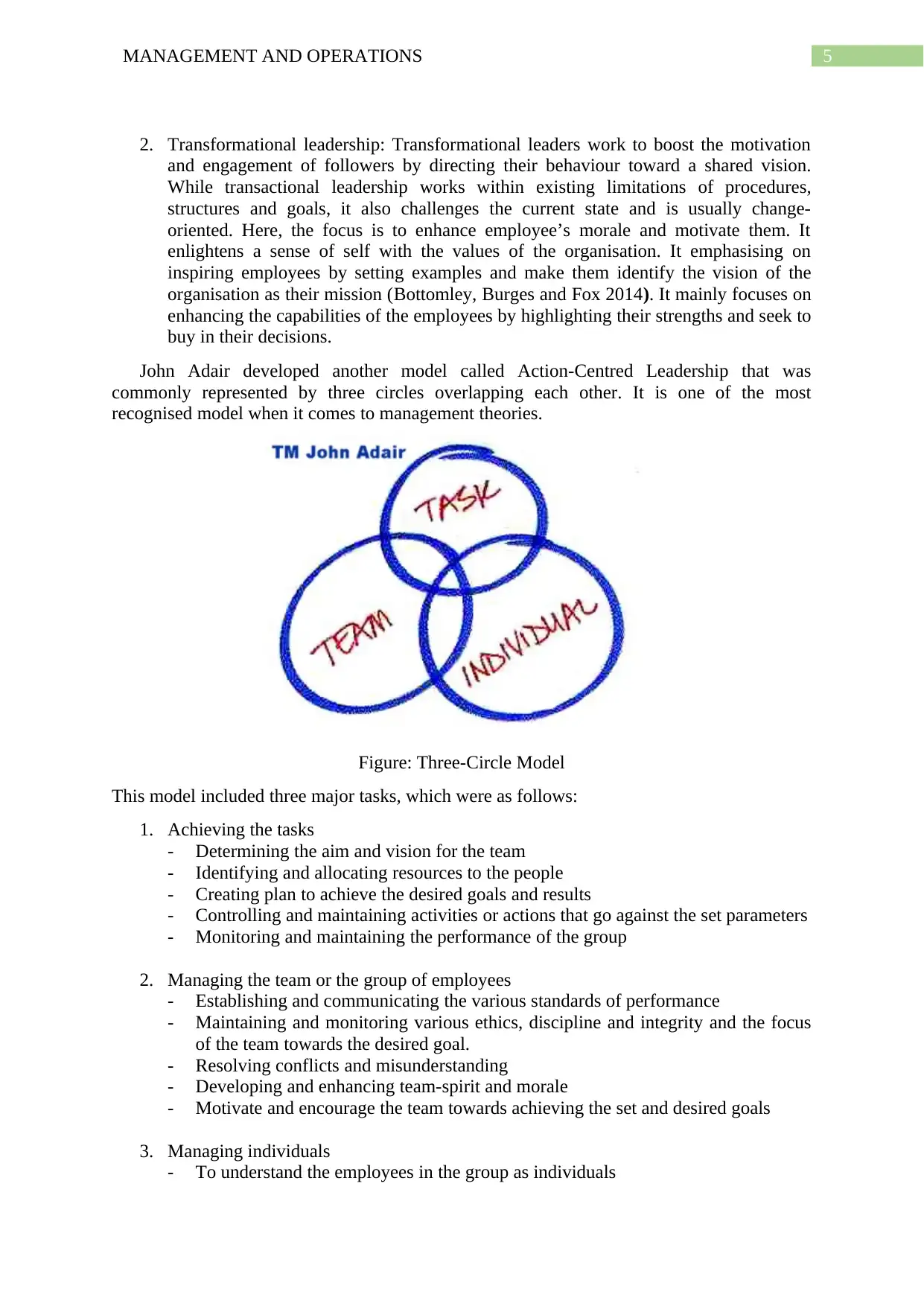
5MANAGEMENT AND OPERATIONS
2. Transformational leadership: Transformational leaders work to boost the motivation
and engagement of followers by directing their behaviour toward a shared vision.
While transactional leadership works within existing limitations of procedures,
structures and goals, it also challenges the current state and is usually change-
oriented. Here, the focus is to enhance employee’s morale and motivate them. It
enlightens a sense of self with the values of the organisation. It emphasising on
inspiring employees by setting examples and make them identify the vision of the
organisation as their mission (Bottomley, Burges and Fox 2014). It mainly focuses on
enhancing the capabilities of the employees by highlighting their strengths and seek to
buy in their decisions.
John Adair developed another model called Action-Centred Leadership that was
commonly represented by three circles overlapping each other. It is one of the most
recognised model when it comes to management theories.
Figure: Three-Circle Model
This model included three major tasks, which were as follows:
1. Achieving the tasks
- Determining the aim and vision for the team
- Identifying and allocating resources to the people
- Creating plan to achieve the desired goals and results
- Controlling and maintaining activities or actions that go against the set parameters
- Monitoring and maintaining the performance of the group
2. Managing the team or the group of employees
- Establishing and communicating the various standards of performance
- Maintaining and monitoring various ethics, discipline and integrity and the focus
of the team towards the desired goal.
- Resolving conflicts and misunderstanding
- Developing and enhancing team-spirit and morale
- Motivate and encourage the team towards achieving the set and desired goals
3. Managing individuals
- To understand the employees in the group as individuals
2. Transformational leadership: Transformational leaders work to boost the motivation
and engagement of followers by directing their behaviour toward a shared vision.
While transactional leadership works within existing limitations of procedures,
structures and goals, it also challenges the current state and is usually change-
oriented. Here, the focus is to enhance employee’s morale and motivate them. It
enlightens a sense of self with the values of the organisation. It emphasising on
inspiring employees by setting examples and make them identify the vision of the
organisation as their mission (Bottomley, Burges and Fox 2014). It mainly focuses on
enhancing the capabilities of the employees by highlighting their strengths and seek to
buy in their decisions.
John Adair developed another model called Action-Centred Leadership that was
commonly represented by three circles overlapping each other. It is one of the most
recognised model when it comes to management theories.
Figure: Three-Circle Model
This model included three major tasks, which were as follows:
1. Achieving the tasks
- Determining the aim and vision for the team
- Identifying and allocating resources to the people
- Creating plan to achieve the desired goals and results
- Controlling and maintaining activities or actions that go against the set parameters
- Monitoring and maintaining the performance of the group
2. Managing the team or the group of employees
- Establishing and communicating the various standards of performance
- Maintaining and monitoring various ethics, discipline and integrity and the focus
of the team towards the desired goal.
- Resolving conflicts and misunderstanding
- Developing and enhancing team-spirit and morale
- Motivate and encourage the team towards achieving the set and desired goals
3. Managing individuals
- To understand the employees in the group as individuals
⊘ This is a preview!⊘
Do you want full access?
Subscribe today to unlock all pages.

Trusted by 1+ million students worldwide
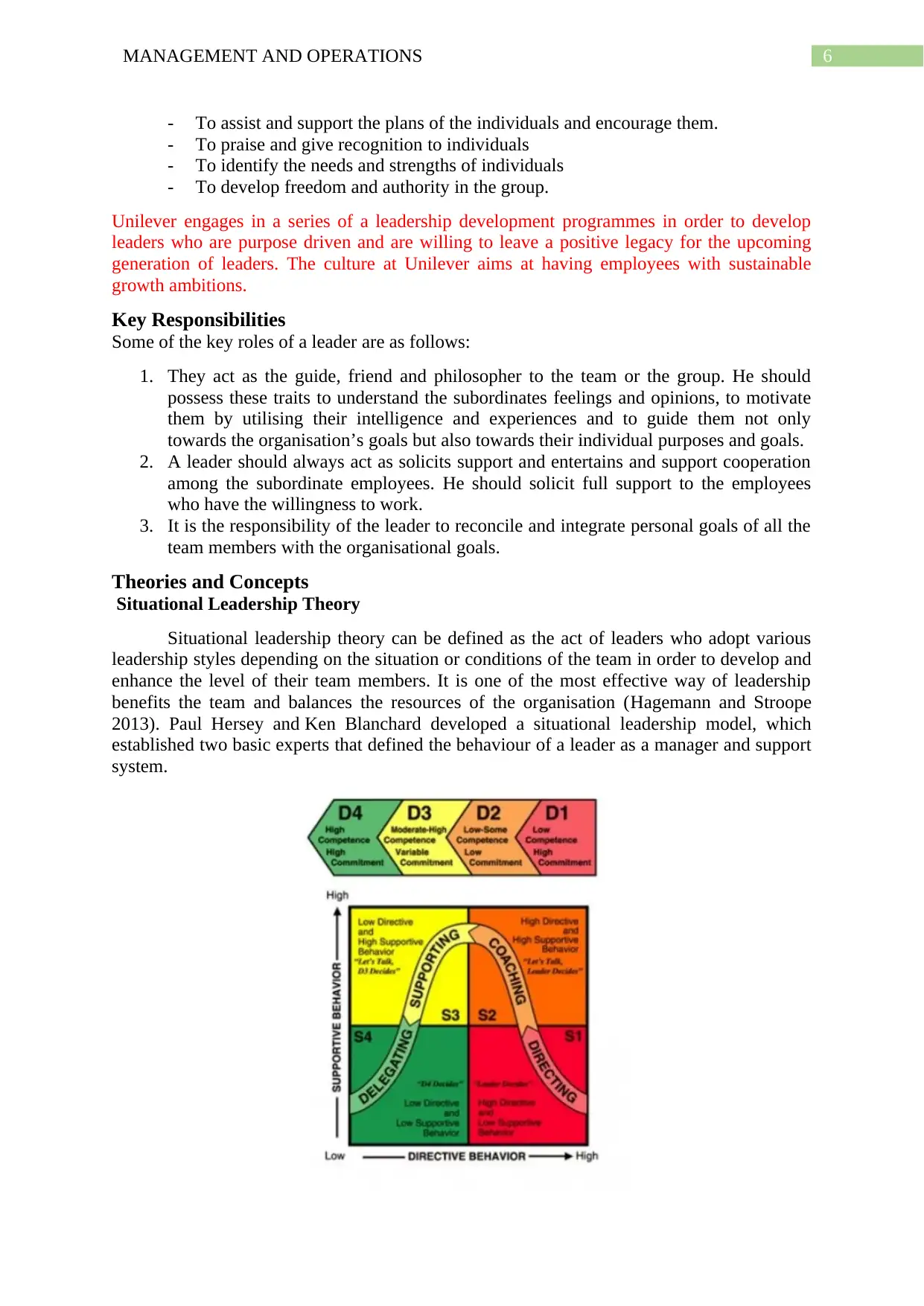
6MANAGEMENT AND OPERATIONS
- To assist and support the plans of the individuals and encourage them.
- To praise and give recognition to individuals
- To identify the needs and strengths of individuals
- To develop freedom and authority in the group.
Unilever engages in a series of a leadership development programmes in order to develop
leaders who are purpose driven and are willing to leave a positive legacy for the upcoming
generation of leaders. The culture at Unilever aims at having employees with sustainable
growth ambitions.
Key Responsibilities
Some of the key roles of a leader are as follows:
1. They act as the guide, friend and philosopher to the team or the group. He should
possess these traits to understand the subordinates feelings and opinions, to motivate
them by utilising their intelligence and experiences and to guide them not only
towards the organisation’s goals but also towards their individual purposes and goals.
2. A leader should always act as solicits support and entertains and support cooperation
among the subordinate employees. He should solicit full support to the employees
who have the willingness to work.
3. It is the responsibility of the leader to reconcile and integrate personal goals of all the
team members with the organisational goals.
Theories and Concepts
Situational Leadership Theory
Situational leadership theory can be defined as the act of leaders who adopt various
leadership styles depending on the situation or conditions of the team in order to develop and
enhance the level of their team members. It is one of the most effective way of leadership
benefits the team and balances the resources of the organisation (Hagemann and Stroope
2013). Paul Hersey and Ken Blanchard developed a situational leadership model, which
established two basic experts that defined the behaviour of a leader as a manager and support
system.
- To assist and support the plans of the individuals and encourage them.
- To praise and give recognition to individuals
- To identify the needs and strengths of individuals
- To develop freedom and authority in the group.
Unilever engages in a series of a leadership development programmes in order to develop
leaders who are purpose driven and are willing to leave a positive legacy for the upcoming
generation of leaders. The culture at Unilever aims at having employees with sustainable
growth ambitions.
Key Responsibilities
Some of the key roles of a leader are as follows:
1. They act as the guide, friend and philosopher to the team or the group. He should
possess these traits to understand the subordinates feelings and opinions, to motivate
them by utilising their intelligence and experiences and to guide them not only
towards the organisation’s goals but also towards their individual purposes and goals.
2. A leader should always act as solicits support and entertains and support cooperation
among the subordinate employees. He should solicit full support to the employees
who have the willingness to work.
3. It is the responsibility of the leader to reconcile and integrate personal goals of all the
team members with the organisational goals.
Theories and Concepts
Situational Leadership Theory
Situational leadership theory can be defined as the act of leaders who adopt various
leadership styles depending on the situation or conditions of the team in order to develop and
enhance the level of their team members. It is one of the most effective way of leadership
benefits the team and balances the resources of the organisation (Hagemann and Stroope
2013). Paul Hersey and Ken Blanchard developed a situational leadership model, which
established two basic experts that defined the behaviour of a leader as a manager and support
system.
Paraphrase This Document
Need a fresh take? Get an instant paraphrase of this document with our AI Paraphraser
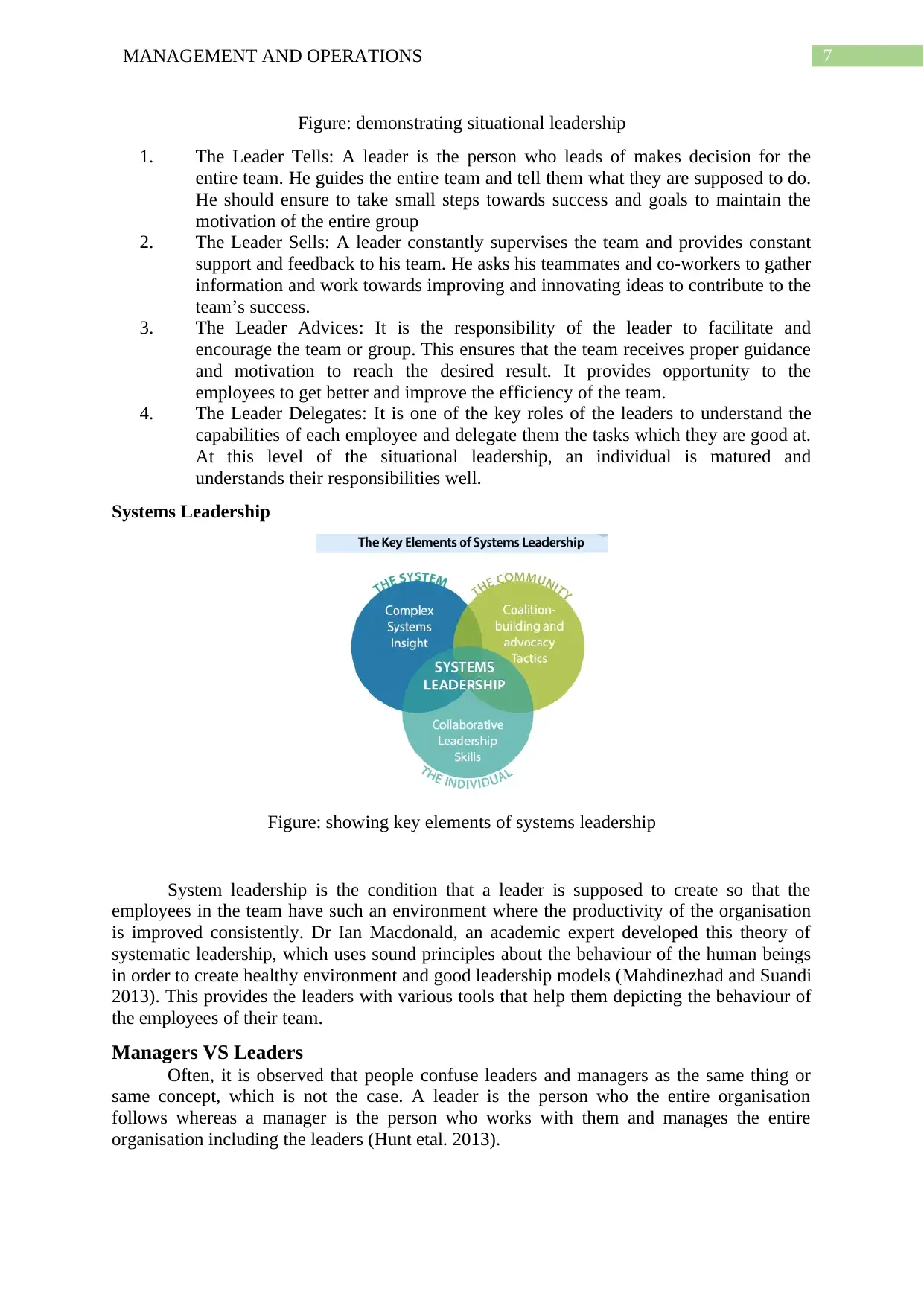
7MANAGEMENT AND OPERATIONS
Figure: demonstrating situational leadership
1. The Leader Tells: A leader is the person who leads of makes decision for the
entire team. He guides the entire team and tell them what they are supposed to do.
He should ensure to take small steps towards success and goals to maintain the
motivation of the entire group
2. The Leader Sells: A leader constantly supervises the team and provides constant
support and feedback to his team. He asks his teammates and co-workers to gather
information and work towards improving and innovating ideas to contribute to the
team’s success.
3. The Leader Advices: It is the responsibility of the leader to facilitate and
encourage the team or group. This ensures that the team receives proper guidance
and motivation to reach the desired result. It provides opportunity to the
employees to get better and improve the efficiency of the team.
4. The Leader Delegates: It is one of the key roles of the leaders to understand the
capabilities of each employee and delegate them the tasks which they are good at.
At this level of the situational leadership, an individual is matured and
understands their responsibilities well.
Systems Leadership
Figure: showing key elements of systems leadership
System leadership is the condition that a leader is supposed to create so that the
employees in the team have such an environment where the productivity of the organisation
is improved consistently. Dr Ian Macdonald, an academic expert developed this theory of
systematic leadership, which uses sound principles about the behaviour of the human beings
in order to create healthy environment and good leadership models (Mahdinezhad and Suandi
2013). This provides the leaders with various tools that help them depicting the behaviour of
the employees of their team.
Managers VS Leaders
Often, it is observed that people confuse leaders and managers as the same thing or
same concept, which is not the case. A leader is the person who the entire organisation
follows whereas a manager is the person who works with them and manages the entire
organisation including the leaders (Hunt etal. 2013).
Figure: demonstrating situational leadership
1. The Leader Tells: A leader is the person who leads of makes decision for the
entire team. He guides the entire team and tell them what they are supposed to do.
He should ensure to take small steps towards success and goals to maintain the
motivation of the entire group
2. The Leader Sells: A leader constantly supervises the team and provides constant
support and feedback to his team. He asks his teammates and co-workers to gather
information and work towards improving and innovating ideas to contribute to the
team’s success.
3. The Leader Advices: It is the responsibility of the leader to facilitate and
encourage the team or group. This ensures that the team receives proper guidance
and motivation to reach the desired result. It provides opportunity to the
employees to get better and improve the efficiency of the team.
4. The Leader Delegates: It is one of the key roles of the leaders to understand the
capabilities of each employee and delegate them the tasks which they are good at.
At this level of the situational leadership, an individual is matured and
understands their responsibilities well.
Systems Leadership
Figure: showing key elements of systems leadership
System leadership is the condition that a leader is supposed to create so that the
employees in the team have such an environment where the productivity of the organisation
is improved consistently. Dr Ian Macdonald, an academic expert developed this theory of
systematic leadership, which uses sound principles about the behaviour of the human beings
in order to create healthy environment and good leadership models (Mahdinezhad and Suandi
2013). This provides the leaders with various tools that help them depicting the behaviour of
the employees of their team.
Managers VS Leaders
Often, it is observed that people confuse leaders and managers as the same thing or
same concept, which is not the case. A leader is the person who the entire organisation
follows whereas a manager is the person who works with them and manages the entire
organisation including the leaders (Hunt etal. 2013).

8MANAGEMENT AND OPERATIONS
A manager is the person who manages the people, resources, finances and operation
in an organisation. It is a wider term than leadership. Every manager is a leader but every
leader is not a manager. Managers operates only in a formal structure companies or
organisations such as corporates or listed companies. Managers are not required in an
informal group or activity. A manager is responsible for planning, organising, directing and
controlling various activities in an organisation in such a manner that enhances the
productivity of the organisation. They are formal authority, mainly task oriented and have a
position in the management hierarchy.
Whereas, a leader is the person who leads a team or a group of person in an
organisation, delegates them the tasks and define the activities they are supposed to do.
Leadership is a narrow concept, every leader might not necessarily be a manager. For
example a leader of the labour union is not their manager. Leaders are found both in a formal
as well as informally structured organisations. A leader is responsible for guiding, inspiring
and being a role model for his team and employees in his group. It is the role of the leader to
make the organisation’s environment a comfortable for his people. Leaders are mainly people
oriented and focus on passion, creativity and imagination of the leader
Conclusion
Hence, in a nutshell it can be said that though there are various differences between
a leader and the manager of an organisation but the key objective of both is the same.
From the above discussion it can be clearly said that a manager is always the leader of the
organisation, however, a leader might not be the manager. It is vital to understand that both
the leader and the manager of an organisation aims at improving the productivity of the
organisation and strives at growing and taking the organisation to another level. This
report helped at analysing the difference between the function of a manager and the role of
a leader. It briefly explained the characteristics, behaviours and traits which support
effective management and leadership.
A manager is the person who manages the people, resources, finances and operation
in an organisation. It is a wider term than leadership. Every manager is a leader but every
leader is not a manager. Managers operates only in a formal structure companies or
organisations such as corporates or listed companies. Managers are not required in an
informal group or activity. A manager is responsible for planning, organising, directing and
controlling various activities in an organisation in such a manner that enhances the
productivity of the organisation. They are formal authority, mainly task oriented and have a
position in the management hierarchy.
Whereas, a leader is the person who leads a team or a group of person in an
organisation, delegates them the tasks and define the activities they are supposed to do.
Leadership is a narrow concept, every leader might not necessarily be a manager. For
example a leader of the labour union is not their manager. Leaders are found both in a formal
as well as informally structured organisations. A leader is responsible for guiding, inspiring
and being a role model for his team and employees in his group. It is the role of the leader to
make the organisation’s environment a comfortable for his people. Leaders are mainly people
oriented and focus on passion, creativity and imagination of the leader
Conclusion
Hence, in a nutshell it can be said that though there are various differences between
a leader and the manager of an organisation but the key objective of both is the same.
From the above discussion it can be clearly said that a manager is always the leader of the
organisation, however, a leader might not be the manager. It is vital to understand that both
the leader and the manager of an organisation aims at improving the productivity of the
organisation and strives at growing and taking the organisation to another level. This
report helped at analysing the difference between the function of a manager and the role of
a leader. It briefly explained the characteristics, behaviours and traits which support
effective management and leadership.
⊘ This is a preview!⊘
Do you want full access?
Subscribe today to unlock all pages.

Trusted by 1+ million students worldwide
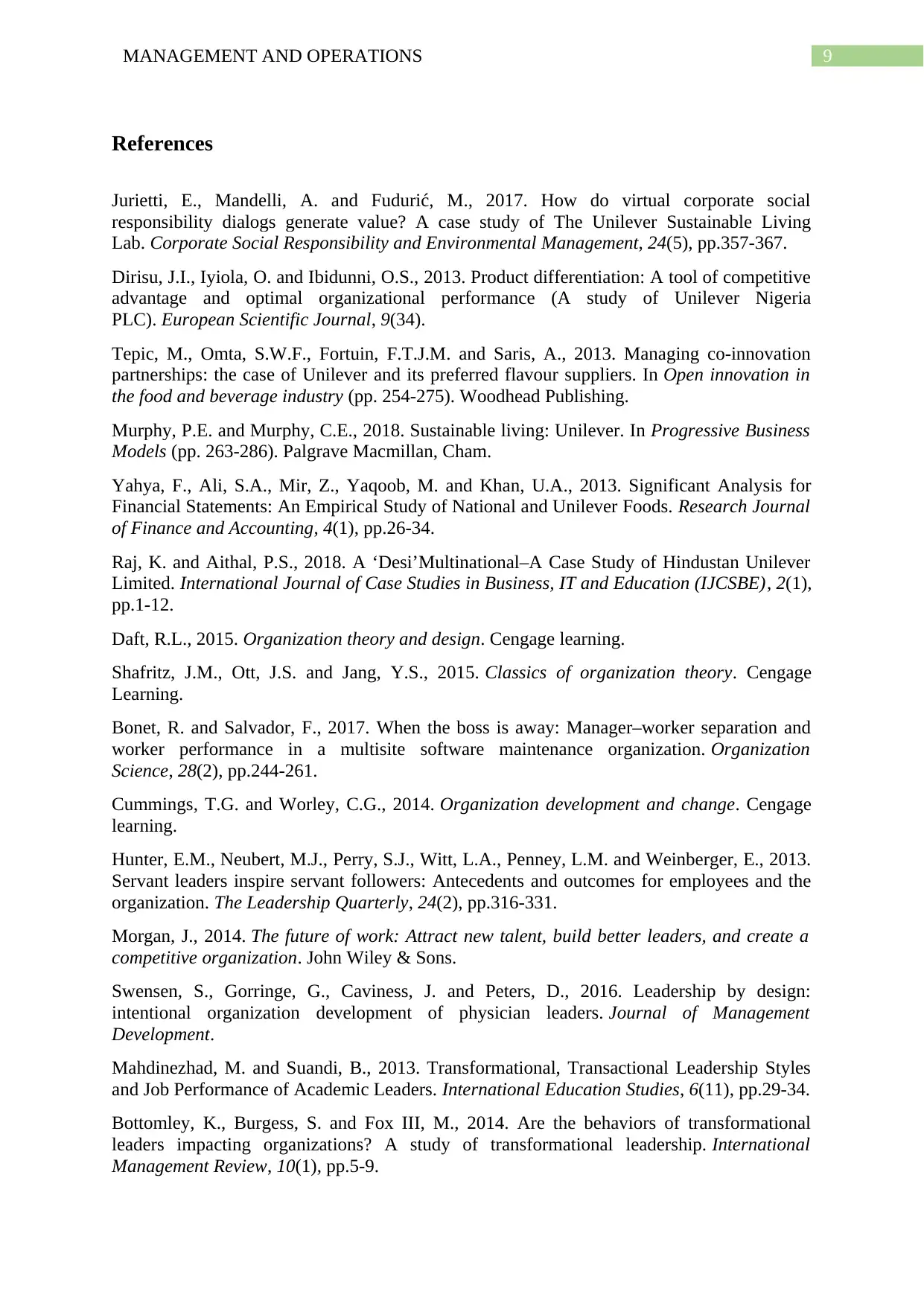
9MANAGEMENT AND OPERATIONS
References
Jurietti, E., Mandelli, A. and Fudurić, M., 2017. How do virtual corporate social
responsibility dialogs generate value? A case study of The Unilever Sustainable Living
Lab. Corporate Social Responsibility and Environmental Management, 24(5), pp.357-367.
Dirisu, J.I., Iyiola, O. and Ibidunni, O.S., 2013. Product differentiation: A tool of competitive
advantage and optimal organizational performance (A study of Unilever Nigeria
PLC). European Scientific Journal, 9(34).
Tepic, M., Omta, S.W.F., Fortuin, F.T.J.M. and Saris, A., 2013. Managing co-innovation
partnerships: the case of Unilever and its preferred flavour suppliers. In Open innovation in
the food and beverage industry (pp. 254-275). Woodhead Publishing.
Murphy, P.E. and Murphy, C.E., 2018. Sustainable living: Unilever. In Progressive Business
Models (pp. 263-286). Palgrave Macmillan, Cham.
Yahya, F., Ali, S.A., Mir, Z., Yaqoob, M. and Khan, U.A., 2013. Significant Analysis for
Financial Statements: An Empirical Study of National and Unilever Foods. Research Journal
of Finance and Accounting, 4(1), pp.26-34.
Raj, K. and Aithal, P.S., 2018. A ‘Desi’Multinational–A Case Study of Hindustan Unilever
Limited. International Journal of Case Studies in Business, IT and Education (IJCSBE), 2(1),
pp.1-12.
Daft, R.L., 2015. Organization theory and design. Cengage learning.
Shafritz, J.M., Ott, J.S. and Jang, Y.S., 2015. Classics of organization theory. Cengage
Learning.
Bonet, R. and Salvador, F., 2017. When the boss is away: Manager–worker separation and
worker performance in a multisite software maintenance organization. Organization
Science, 28(2), pp.244-261.
Cummings, T.G. and Worley, C.G., 2014. Organization development and change. Cengage
learning.
Hunter, E.M., Neubert, M.J., Perry, S.J., Witt, L.A., Penney, L.M. and Weinberger, E., 2013.
Servant leaders inspire servant followers: Antecedents and outcomes for employees and the
organization. The Leadership Quarterly, 24(2), pp.316-331.
Morgan, J., 2014. The future of work: Attract new talent, build better leaders, and create a
competitive organization. John Wiley & Sons.
Swensen, S., Gorringe, G., Caviness, J. and Peters, D., 2016. Leadership by design:
intentional organization development of physician leaders. Journal of Management
Development.
Mahdinezhad, M. and Suandi, B., 2013. Transformational, Transactional Leadership Styles
and Job Performance of Academic Leaders. International Education Studies, 6(11), pp.29-34.
Bottomley, K., Burgess, S. and Fox III, M., 2014. Are the behaviors of transformational
leaders impacting organizations? A study of transformational leadership. International
Management Review, 10(1), pp.5-9.
References
Jurietti, E., Mandelli, A. and Fudurić, M., 2017. How do virtual corporate social
responsibility dialogs generate value? A case study of The Unilever Sustainable Living
Lab. Corporate Social Responsibility and Environmental Management, 24(5), pp.357-367.
Dirisu, J.I., Iyiola, O. and Ibidunni, O.S., 2013. Product differentiation: A tool of competitive
advantage and optimal organizational performance (A study of Unilever Nigeria
PLC). European Scientific Journal, 9(34).
Tepic, M., Omta, S.W.F., Fortuin, F.T.J.M. and Saris, A., 2013. Managing co-innovation
partnerships: the case of Unilever and its preferred flavour suppliers. In Open innovation in
the food and beverage industry (pp. 254-275). Woodhead Publishing.
Murphy, P.E. and Murphy, C.E., 2018. Sustainable living: Unilever. In Progressive Business
Models (pp. 263-286). Palgrave Macmillan, Cham.
Yahya, F., Ali, S.A., Mir, Z., Yaqoob, M. and Khan, U.A., 2013. Significant Analysis for
Financial Statements: An Empirical Study of National and Unilever Foods. Research Journal
of Finance and Accounting, 4(1), pp.26-34.
Raj, K. and Aithal, P.S., 2018. A ‘Desi’Multinational–A Case Study of Hindustan Unilever
Limited. International Journal of Case Studies in Business, IT and Education (IJCSBE), 2(1),
pp.1-12.
Daft, R.L., 2015. Organization theory and design. Cengage learning.
Shafritz, J.M., Ott, J.S. and Jang, Y.S., 2015. Classics of organization theory. Cengage
Learning.
Bonet, R. and Salvador, F., 2017. When the boss is away: Manager–worker separation and
worker performance in a multisite software maintenance organization. Organization
Science, 28(2), pp.244-261.
Cummings, T.G. and Worley, C.G., 2014. Organization development and change. Cengage
learning.
Hunter, E.M., Neubert, M.J., Perry, S.J., Witt, L.A., Penney, L.M. and Weinberger, E., 2013.
Servant leaders inspire servant followers: Antecedents and outcomes for employees and the
organization. The Leadership Quarterly, 24(2), pp.316-331.
Morgan, J., 2014. The future of work: Attract new talent, build better leaders, and create a
competitive organization. John Wiley & Sons.
Swensen, S., Gorringe, G., Caviness, J. and Peters, D., 2016. Leadership by design:
intentional organization development of physician leaders. Journal of Management
Development.
Mahdinezhad, M. and Suandi, B., 2013. Transformational, Transactional Leadership Styles
and Job Performance of Academic Leaders. International Education Studies, 6(11), pp.29-34.
Bottomley, K., Burgess, S. and Fox III, M., 2014. Are the behaviors of transformational
leaders impacting organizations? A study of transformational leadership. International
Management Review, 10(1), pp.5-9.
Paraphrase This Document
Need a fresh take? Get an instant paraphrase of this document with our AI Paraphraser
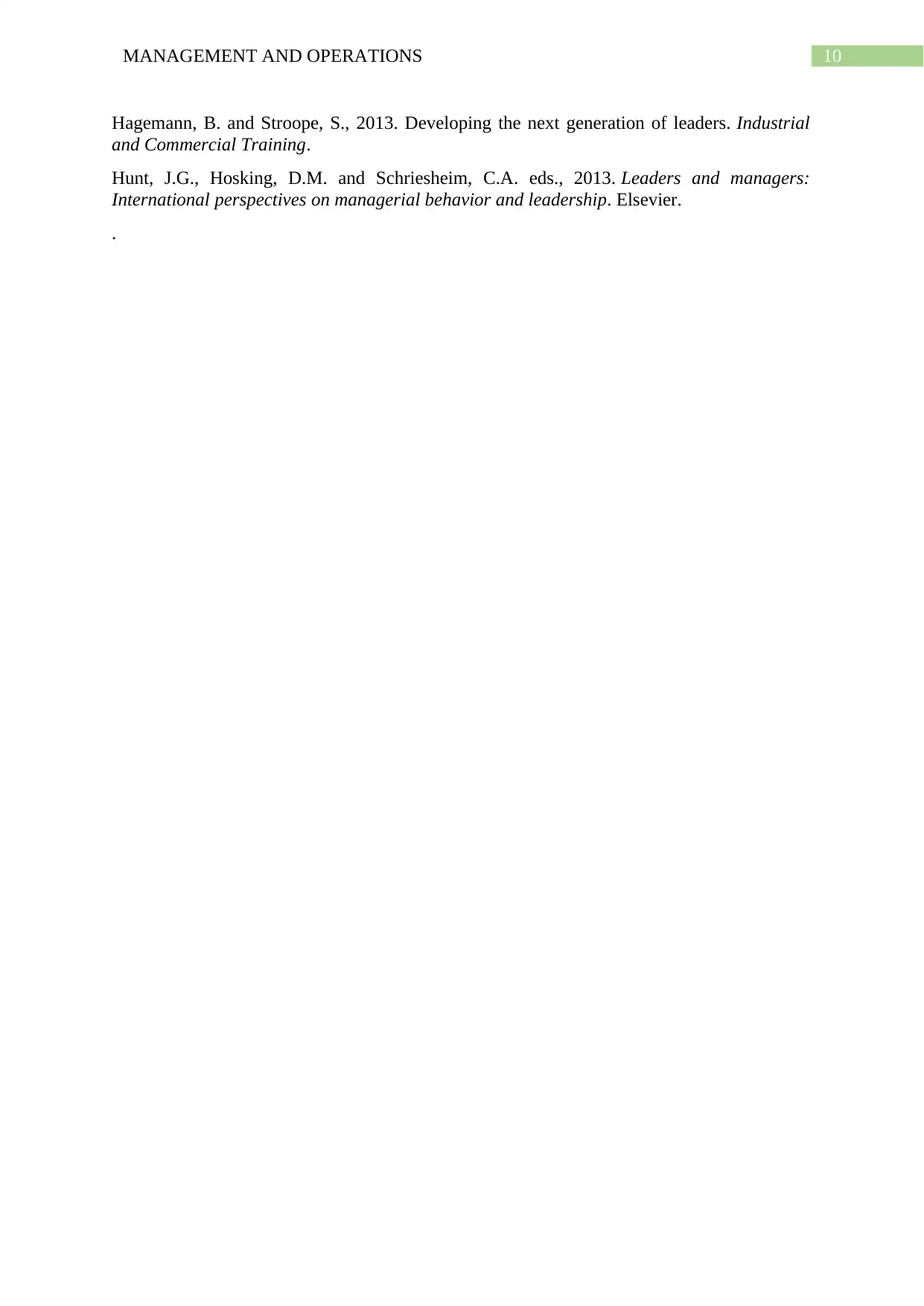
10MANAGEMENT AND OPERATIONS
Hagemann, B. and Stroope, S., 2013. Developing the next generation of leaders. Industrial
and Commercial Training.
Hunt, J.G., Hosking, D.M. and Schriesheim, C.A. eds., 2013. Leaders and managers:
International perspectives on managerial behavior and leadership. Elsevier.
.
Hagemann, B. and Stroope, S., 2013. Developing the next generation of leaders. Industrial
and Commercial Training.
Hunt, J.G., Hosking, D.M. and Schriesheim, C.A. eds., 2013. Leaders and managers:
International perspectives on managerial behavior and leadership. Elsevier.
.
1 out of 11
Related Documents
Your All-in-One AI-Powered Toolkit for Academic Success.
+13062052269
info@desklib.com
Available 24*7 on WhatsApp / Email
![[object Object]](/_next/static/media/star-bottom.7253800d.svg)
Unlock your academic potential
Copyright © 2020–2025 A2Z Services. All Rights Reserved. Developed and managed by ZUCOL.





